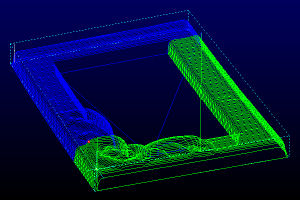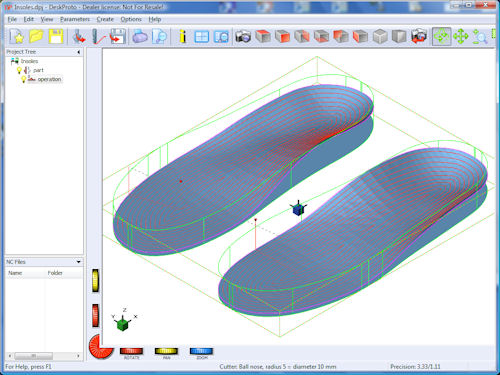3D CAM for Milling and Rapid Prototyping Updated
DeskProto 6.1 for non-machinists working in CAD, rapid prototyping, and mold making includes new offset strategy.
Latest News
November 27, 2013
 This image depicts toolpaths showing the new sorting option in DeskProto 6.1. First, all movements on the right side have been done (displayed in green), after which all movements on the left side will be done. Image courtesy of Delft Spline Systems. |
DeskProto is described by the company as a 3D CAM application for CNC machining intended for non-machinists working in such areas as design, mold making, rapid prototyping, prostheses design, jewelry for wax models, relief carving, and education. It has a wizard interface for new users, and experienced CAM users can manipulate settings directly.
DeskProto imports STL files from any 3D CAD program, calculates CNC toolpaths, and then writes NC (numeric control) program files for CNC milling. Depending on the version, DeskProto supports 3-, 4-, and 5-axis CNC milling machines. The CAM system can import 2D contours in DXF files and execute simple 2D jobs in addition to its 3D functionality. Further, DeskProto can import bitmap images (JPG, GIF, and BMP files) then convert them to 3D reliefs using a grey-value to Z-height conversion technique.
The 6.1 release of DeskProto incorporates a new offset strategy in which toolpaths follow the outer contour of the geometry. The offset strategy was originally developed by request from pedorthists who custom machine insoles. “Beta testing proved that the new strategy works great in many other application areas as well,” explained company spokesperson Lex Lennings in a press statement.
DeskProto comes in Entry, Expert, and Multi-Axis Editions. DeskProto Entry Edition, says the company, is designed for users with tight budgets who need a CAM software system, such as hobbyists, schools, and small companies that only need basic CAM functionality. It offers all the basic toolpath types needed to use your CNC milling machine, including 3D machining of the geometry in an STL file, simple 2D machining of a drawing from a DXF file, and bitmap machining of the picture in a bitmap file (GIF, JPG, and BMP).
The DeskProto Expert Edition builds off the Entry Edition and is described as being for professional designers and engineers who are not machinists. It’s said to offer a wealth of options for producing complicated models, including roughing and finishing operations, the ability to limit the area to be machined using a freeform segment, and dynamic feed-rate control. Toolpath milling strategies include parallel to X, crosswise angled, blocked, spiral, and waterlines. Calculations are said to be fast, even for complex geometries. You can add cutters, machines, and postprocessors freely. DeskProto Expert Edition works with STL files as large as 500MB and, with the 64-bit version of DeskProto Expert Edition, up to several gigabytes.
The DeskProto Multi-Axis Edition offers all the capabilities found in the Expert Edition plus support for 4-axis and 5-axis machining. This version offers continuous rotation axis machining in which a part is rotated by the machine’s fourth axis during machining. DeskProto Multi-Axis Edition’s indexed rotation axis machining uses the fourth axis to machine a part from several sides.
 In this screen shot, the new offset strategy in DeskProto 6.1 has been combined with a freeform segment that was generated around the geometry automatically. Image courtesy of Delft Spline Systems. |
Additional new features in DeskProto 6.1 include an option to automatically generate a freeform segment along the outer contour of the geometry, a display option that shows points on the toolpaths, and sorting for the toolpaths, the latter is said to make them far more efficient.
Enhancements of note for existing users reported include projecting 2D toolpaths on a 3D geometry now uses the cutter geometry, a new “Always stay low” option for 2D operations, larger stepovers for a negative roughing skin, and more accurate Z-values when projecting a 2D contour on 3D geometry. New Toolpath sorting capabilities to prevent unneeded positioning movements have also been incorporated in DeskProto 6.1.
DeskProto V6.1 runs on workstations with 32- or 64-bit Windows XP (Service Pack 3 or newer), Windows Vista, Windows 7, and Windows 8 or newer. The system has been released in English. Chinese, Dutch, German and Spanish. French and Italian will follow soon, according to the company. The new version is a free update for registered V6.0 DeskProto users. For registered users of earlier versions, a discounted update offer is available until the end of the year.
Pricing for DeskProto version 6.1 runs from €145 (approximately $195) for the Entry Edition to €995 (approximately $1345) for the DeskProto Multi-Axis Edition. For complete information on DeskProto 6.1, go to Delft Spline Systems.
Compare features in the different versions of DeskProto.
Download a complimentary 30-day trial version of DeskProto.
Access a library on using CAM, CNC, and DeskProto.
Read some DeskProto application stories.
See why DE’s editors selected DeskProto 6.1 from Delft Spline Systems as their Pick of the Week.
Sources: Press materials received from the company and additional information gleaned from the company’s website.
Subscribe to our FREE magazine, FREE email newsletters or both!
Latest News
About the Author
Anthony J. Lockwood is Digital Engineering’s founding editor. He is now retired. Contact him via [email protected].
Follow DE





